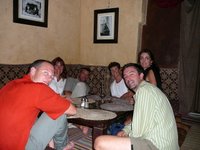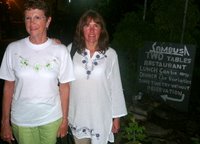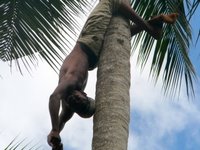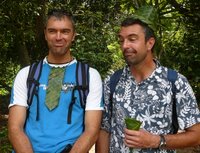
On Thursday we returned from the Serengeti to the Ngurdoto Mountain Lodge near Arusha. I decided that we needed some time to regroup before leaving for Zanzibar so I scheduled the flight for the next day.
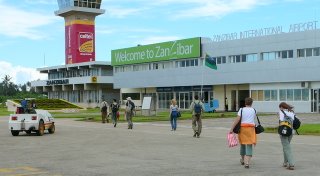 Freshly showered and rested, we had breakfast and headed for the airport Friday morning with our great safari guide, Niemen. He turned out to be such a cool guy. I highly recommend him for anyone heading out on safari. He’s smart and he’ll take good care of you.
Freshly showered and rested, we had breakfast and headed for the airport Friday morning with our great safari guide, Niemen. He turned out to be such a cool guy. I highly recommend him for anyone heading out on safari. He’s smart and he’ll take good care of you.
We arrived at the airport in plenty of time and we had an easy one-hour trip to Zanzibar. The coolness of the Arusha area was replaced by the heat and humidity of the tropical island. Our driver was there to pick us up in a van and we were soon off to Stonetown.
 I booked the rooms in the Tembo Hotel, one of the nicer places in town. I wanted to be near the center, near the water and in a place steeped in Zanzibar style. The Tembo fits the bill. It’s open to debate as to whether you get enough bang for your buck but I like it there.
I booked the rooms in the Tembo Hotel, one of the nicer places in town. I wanted to be near the center, near the water and in a place steeped in Zanzibar style. The Tembo fits the bill. It’s open to debate as to whether you get enough bang for your buck but I like it there.
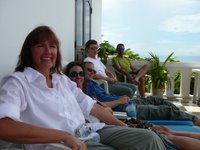 Lisa and Brett were in the “deluxe room” perched high above the ocean front terraces. Curtis, Mom and CJ were in the large “family room”. Priya and I were in a normal room adjacent to the family room. We all checked into our rooms and then met up on the terrace of the large room. Priya was scheduled to arrive from Dar about an hour after our arrival and before too long she appeared. We then set off to explore.
Lisa and Brett were in the “deluxe room” perched high above the ocean front terraces. Curtis, Mom and CJ were in the large “family room”. Priya and I were in a normal room adjacent to the family room. We all checked into our rooms and then met up on the terrace of the large room. Priya was scheduled to arrive from Dar about an hour after our arrival and before too long she appeared. We then set off to explore.
Zanzibar is actually the name of an archipelago of islands which include Unguja, Pemba and a number of other smaller ones. It’s rich in history and culture and stands out from the rest of Tanzania. The principle town, Stonetown, was once known as the major gateway for entrance into and out of eastern Africa. It’s location at the end of the “slave trail” meant that the majority of slaves heading east were transported through its slave market – at its peak about 60,000 per year.
It was also the hub for commerce, especially ivory and spices, being exported from the continent. Many of the beautiful, large, old buildings were originally merchant houses from back in the day, including the Tembo Hotel.
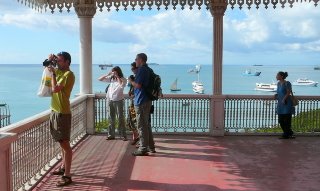 We started off going to a common mzungu eating spot called Archipelago. It was hot and noisy. The food was decent but nothing special. We decided to follow this up with a trip to the House of Wonders, the most prominent piece of architecture in the city and the principle museum in Zanzibar. The building is the former house of the Sultan who governed Zanzibar and juts out prominently above Stonetown’s other buildings. One of the main reasons to go there is the view from the top though the building itself and some of the history is interesting.
We started off going to a common mzungu eating spot called Archipelago. It was hot and noisy. The food was decent but nothing special. We decided to follow this up with a trip to the House of Wonders, the most prominent piece of architecture in the city and the principle museum in Zanzibar. The building is the former house of the Sultan who governed Zanzibar and juts out prominently above Stonetown’s other buildings. One of the main reasons to go there is the view from the top though the building itself and some of the history is interesting.
 Like most of Stonetown, it has the potential to be so much better than it is. It shares a lot of other qualities with its town as well: it’s dirty; the lighting is bad; it’s disorganized and it’s in danger of falling to pieces before any significant funding gets pointed in its direction. In comparison to the deluxe estates that can be found to house government ministers, it’s a glaring symbol of how bad governance is destroying Tanzania and strangling its citizens. I could really take off on that topic but I won’t.
Like most of Stonetown, it has the potential to be so much better than it is. It shares a lot of other qualities with its town as well: it’s dirty; the lighting is bad; it’s disorganized and it’s in danger of falling to pieces before any significant funding gets pointed in its direction. In comparison to the deluxe estates that can be found to house government ministers, it’s a glaring symbol of how bad governance is destroying Tanzania and strangling its citizens. I could really take off on that topic but I won’t.
From there we walked around town, visiting shops and fending off vendors. They are more aggressive on the island than on the mainland and it does make walking less pleasant. Unbeknownst to them, it hurts their business immeasurably. Many regular visitors to Stonetown refuse to walk the charming narrow streets. Those that do more often than not seek refuge in the mzungu-friendly shops such as Memories of Zanzibar. They do have nice things but it’s also because that’s the way Westerners like to shop. The aggressive vendors in the street don’t get it and they continue to chase business away.
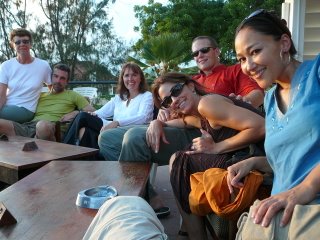 We met up at the Tembo and headed off to the Africa House for a “sundowner”, a drink at sunset. Their terrace is the source of probably more sunset photos than anywhere else in Tanzania. We were not disappointed (though I have been there when it’s a bit better).
We met up at the Tembo and headed off to the Africa House for a “sundowner”, a drink at sunset. Their terrace is the source of probably more sunset photos than anywhere else in Tanzania. We were not disappointed (though I have been there when it’s a bit better).
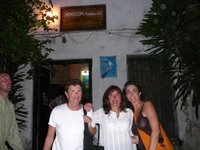 After a couple of drinks were off to the restaurant Monsoon for dinner. It’s a nice place that is more or less Zanzibari. You remove your shoes at the entrance and sit on the floor with pillows and so forth. It’s a nice atmosphere and most of us had good food. I have to admit, it’s cool just simply hanging with family and soaking in the travel experiences.
After a couple of drinks were off to the restaurant Monsoon for dinner. It’s a nice place that is more or less Zanzibari. You remove your shoes at the entrance and sit on the floor with pillows and so forth. It’s a nice atmosphere and most of us had good food. I have to admit, it’s cool just simply hanging with family and soaking in the travel experiences.